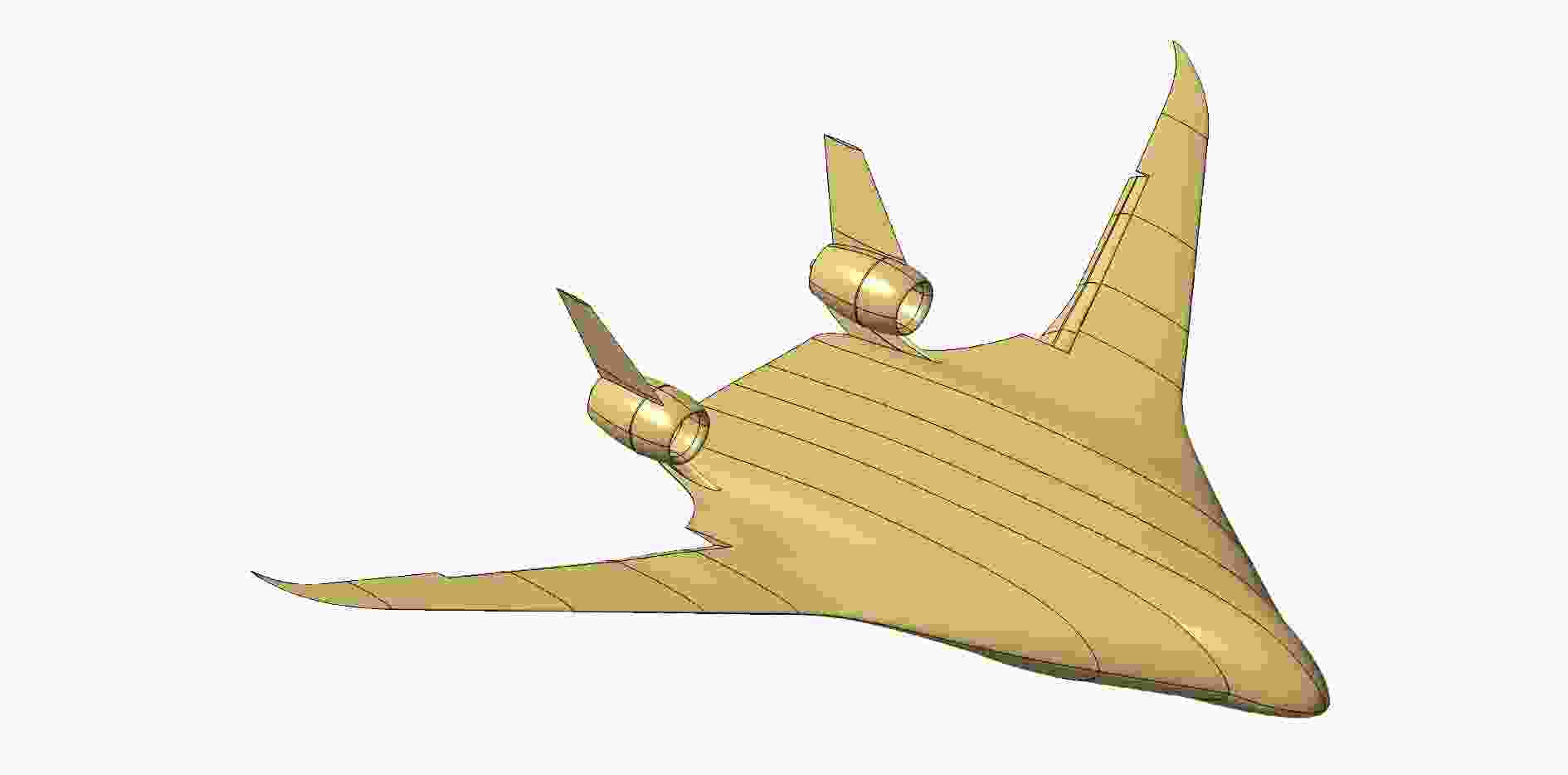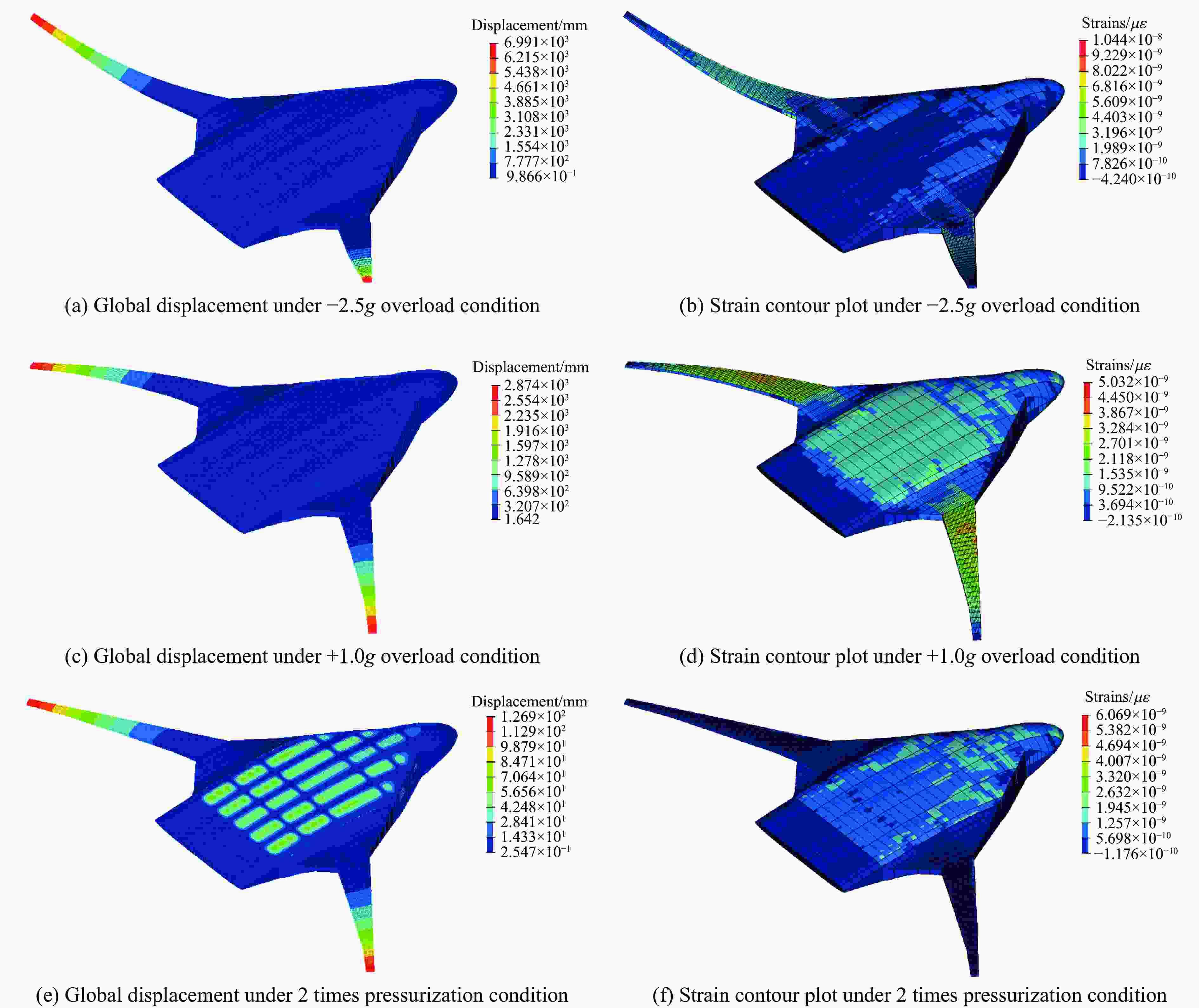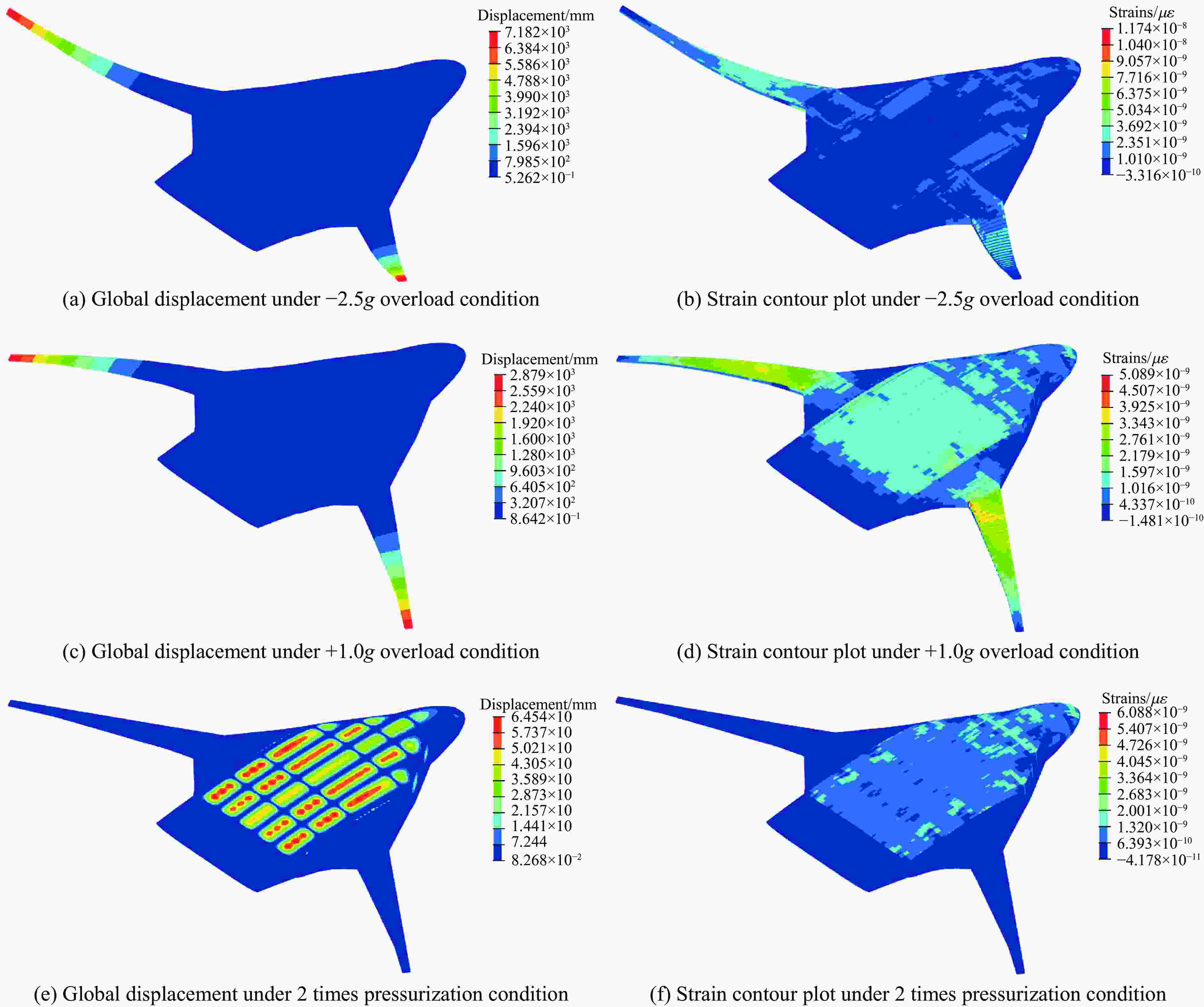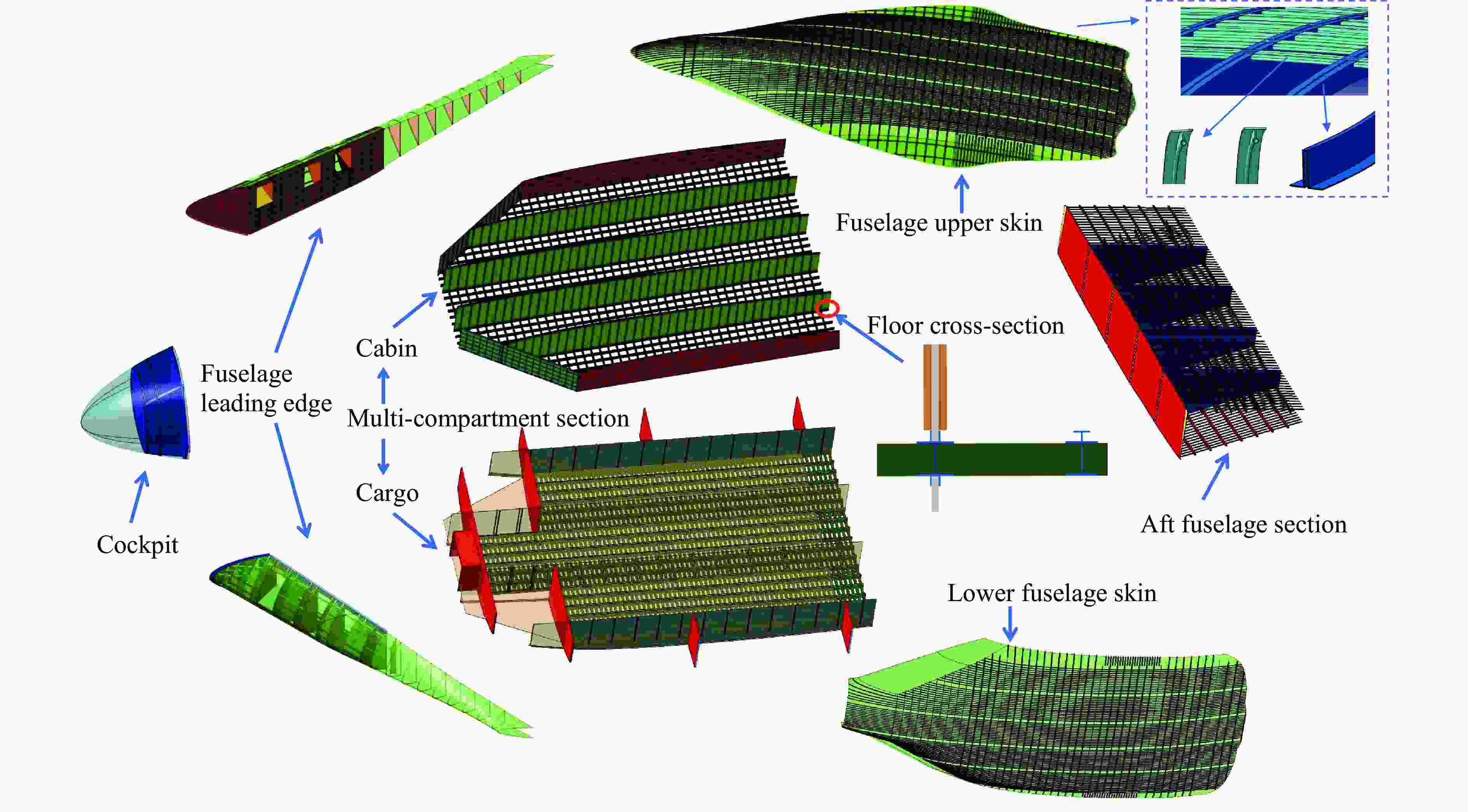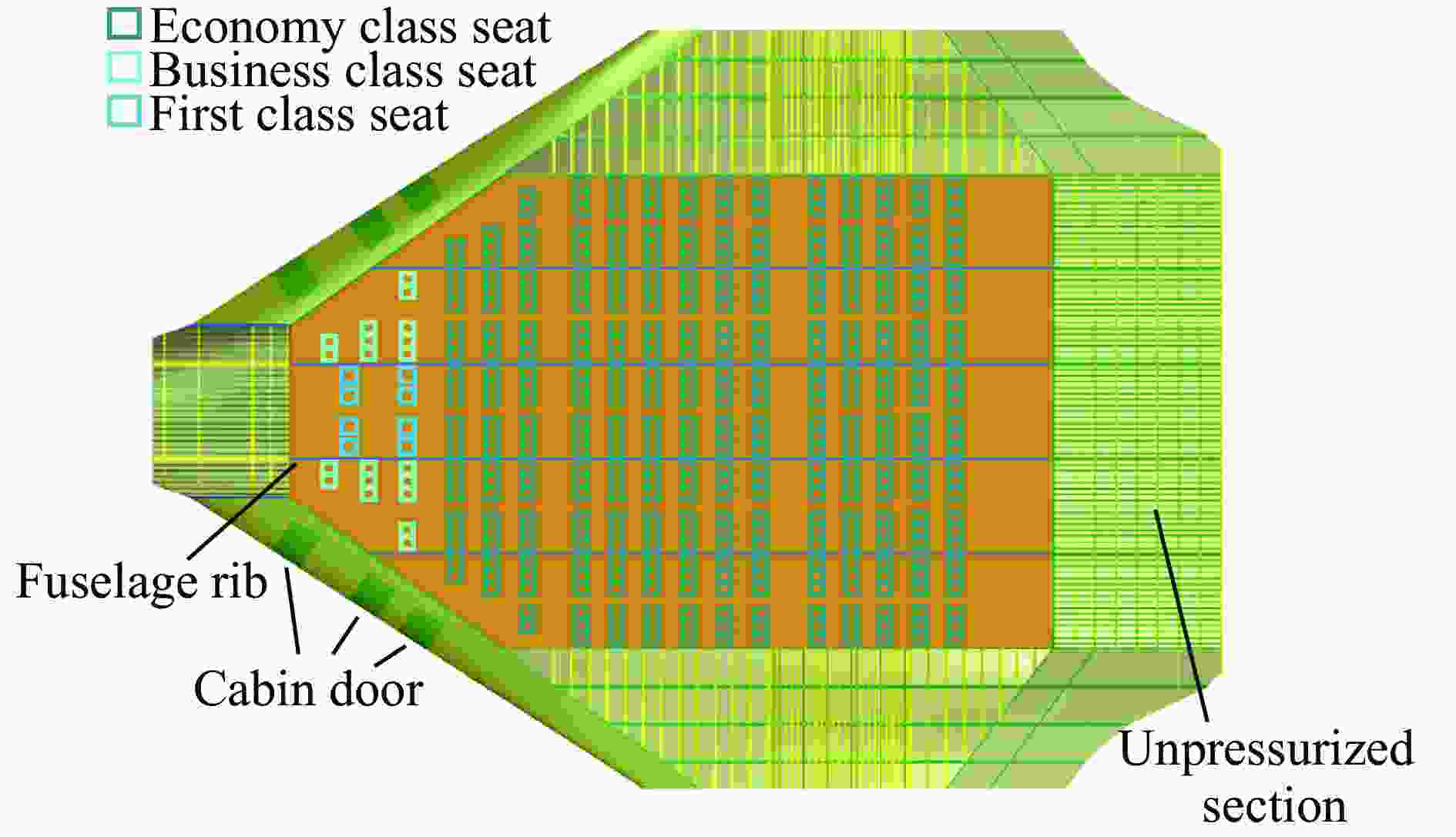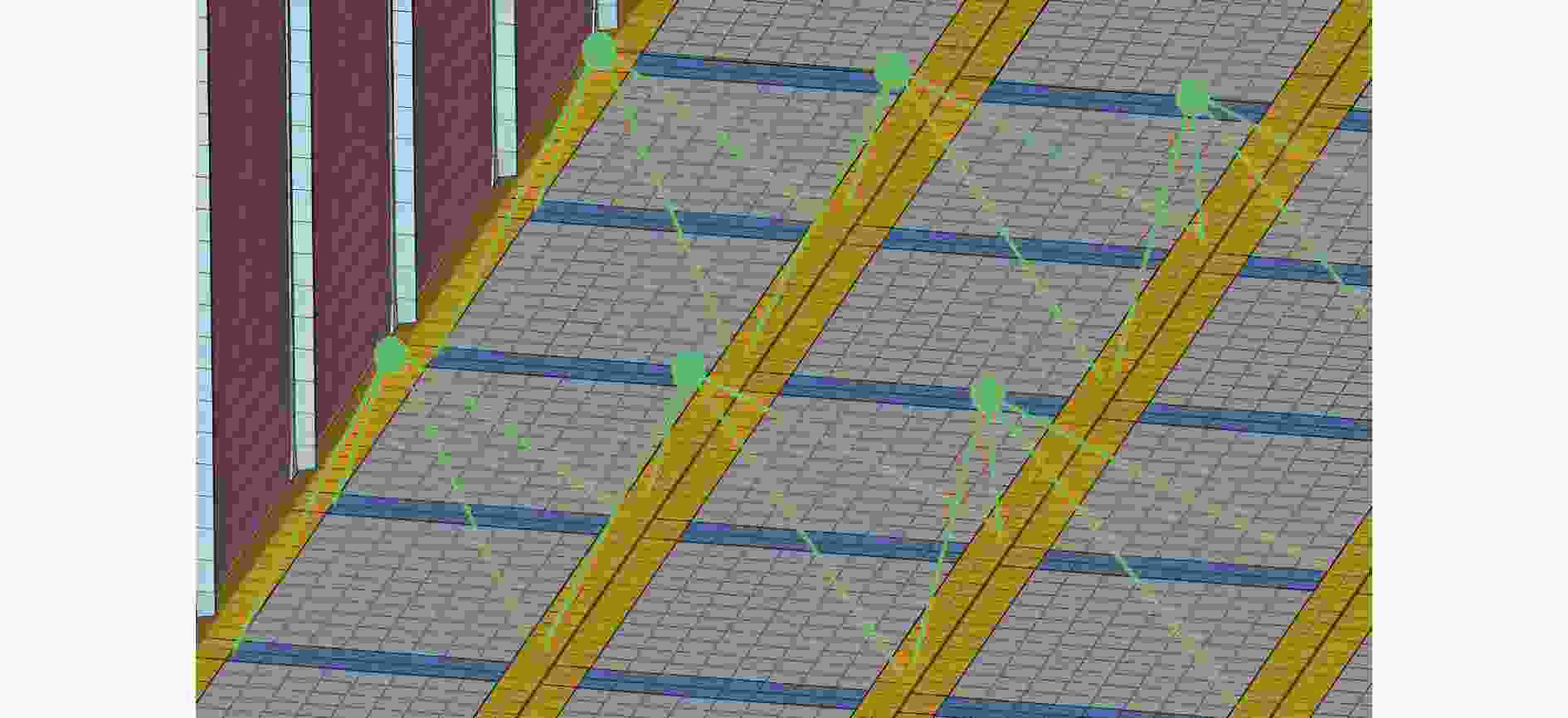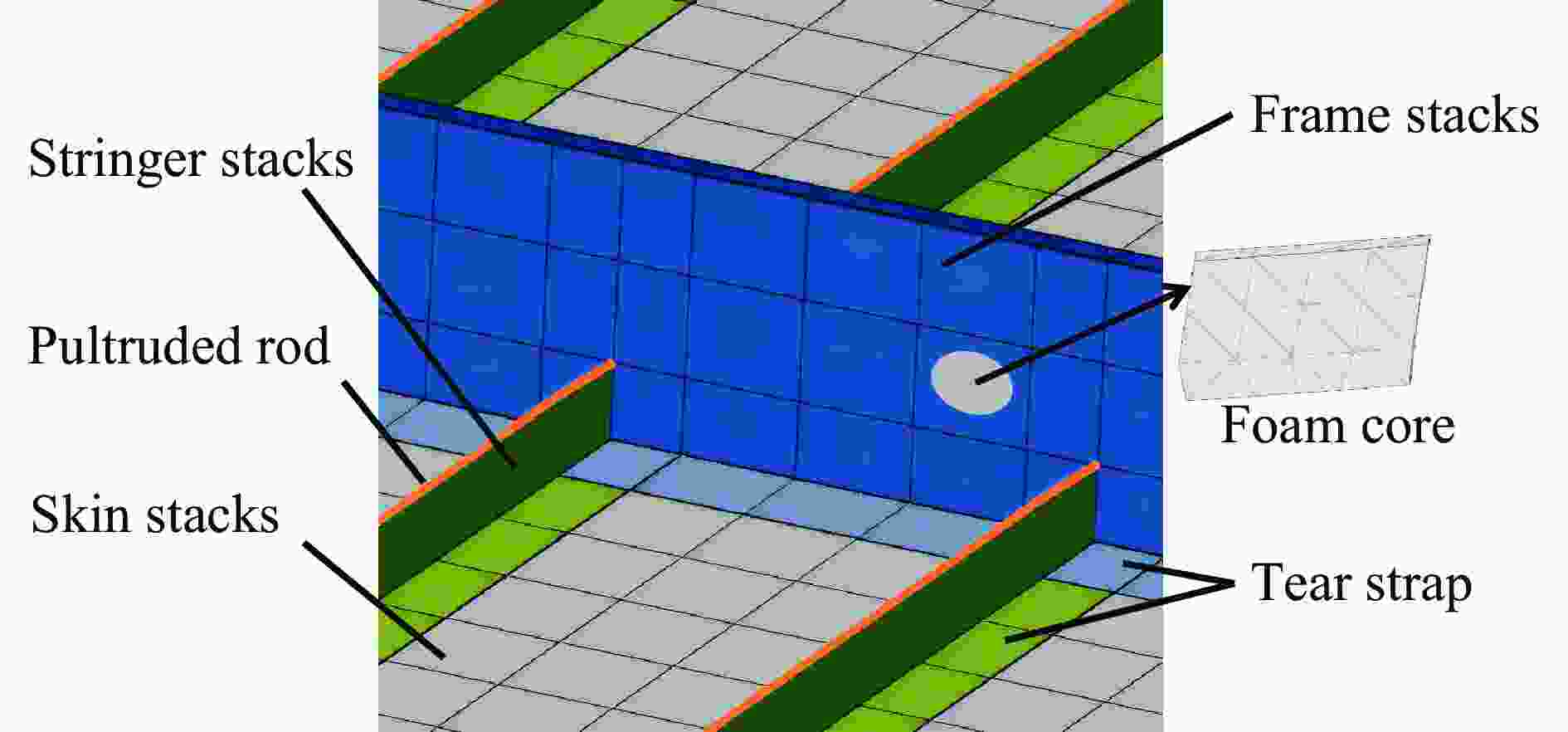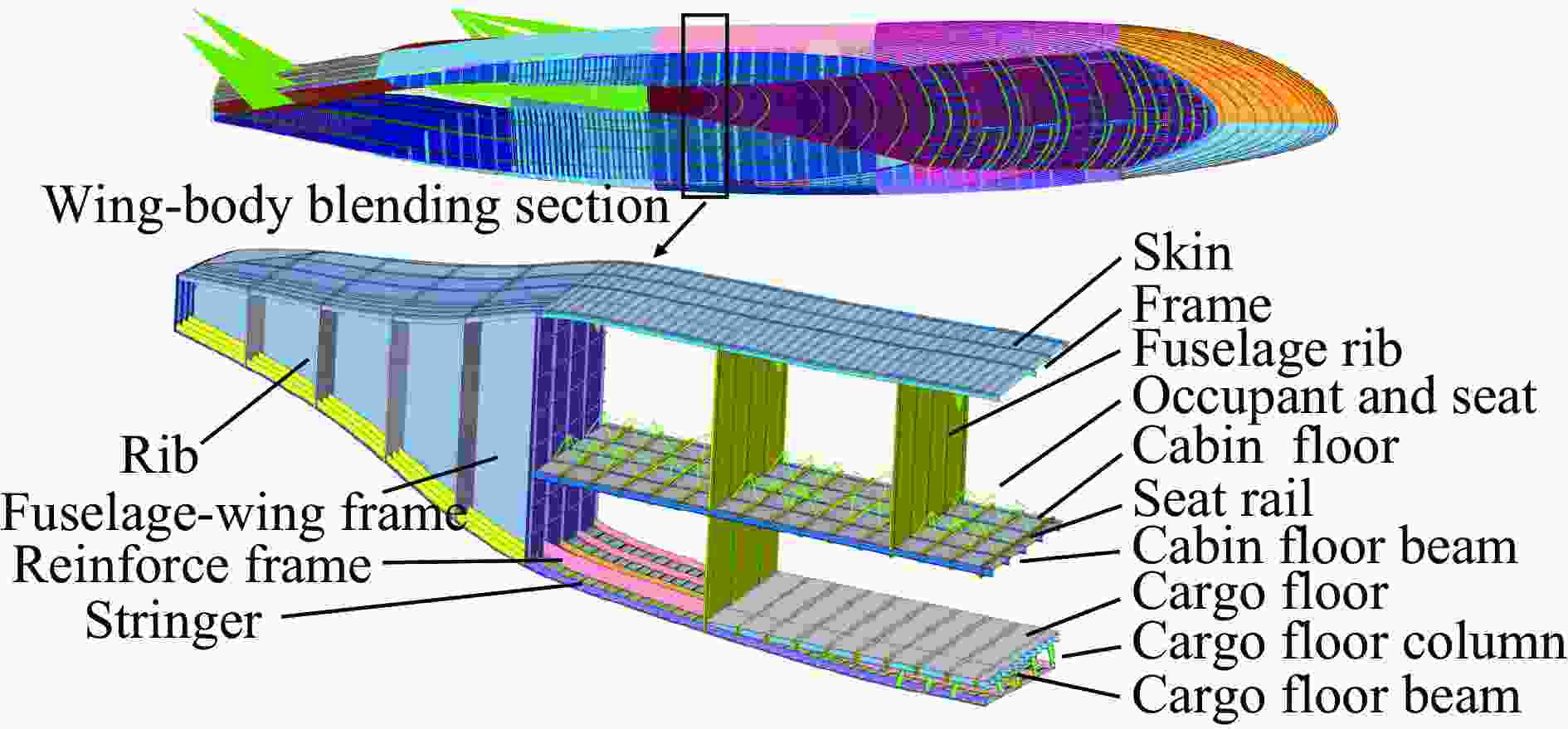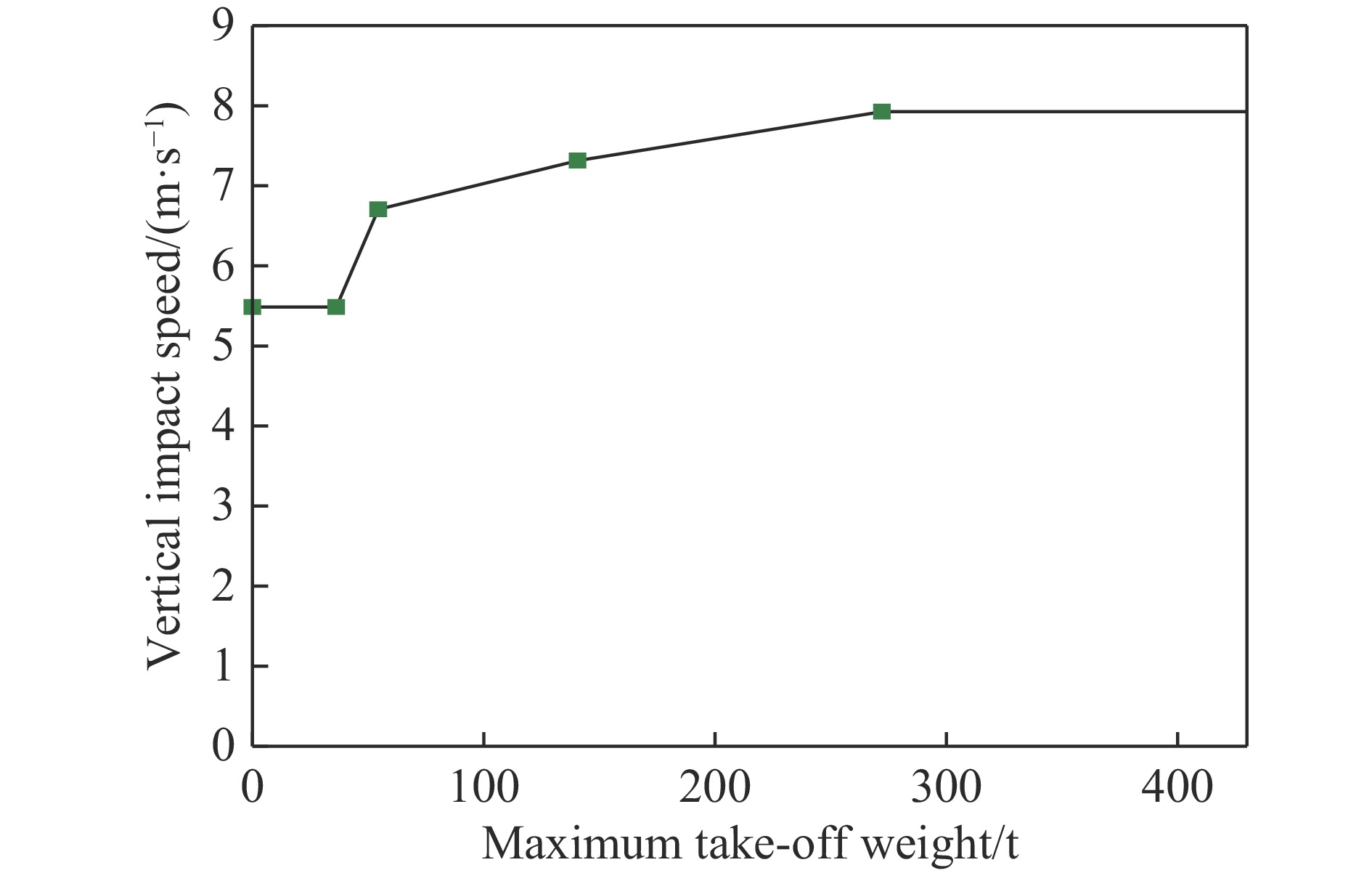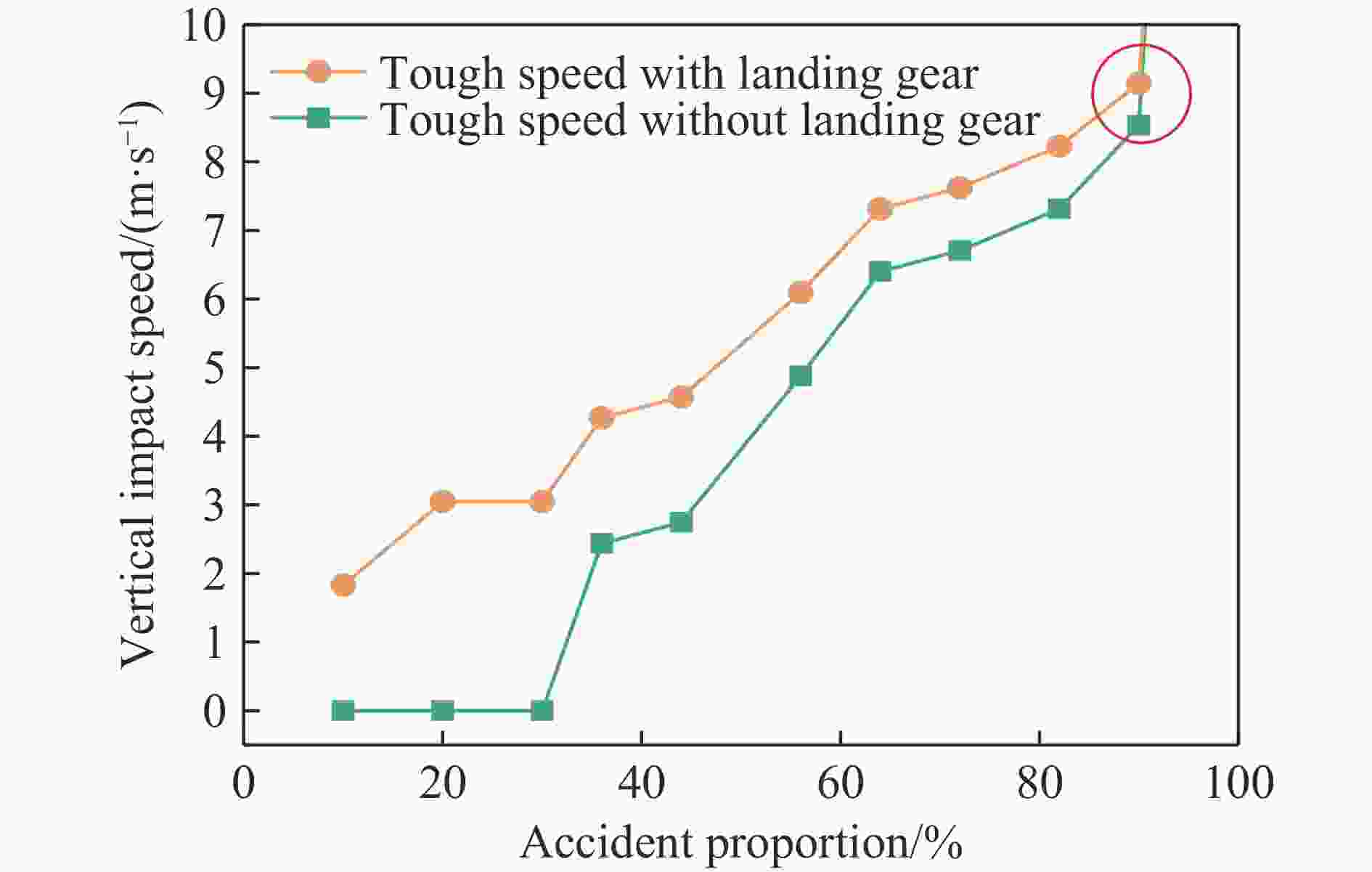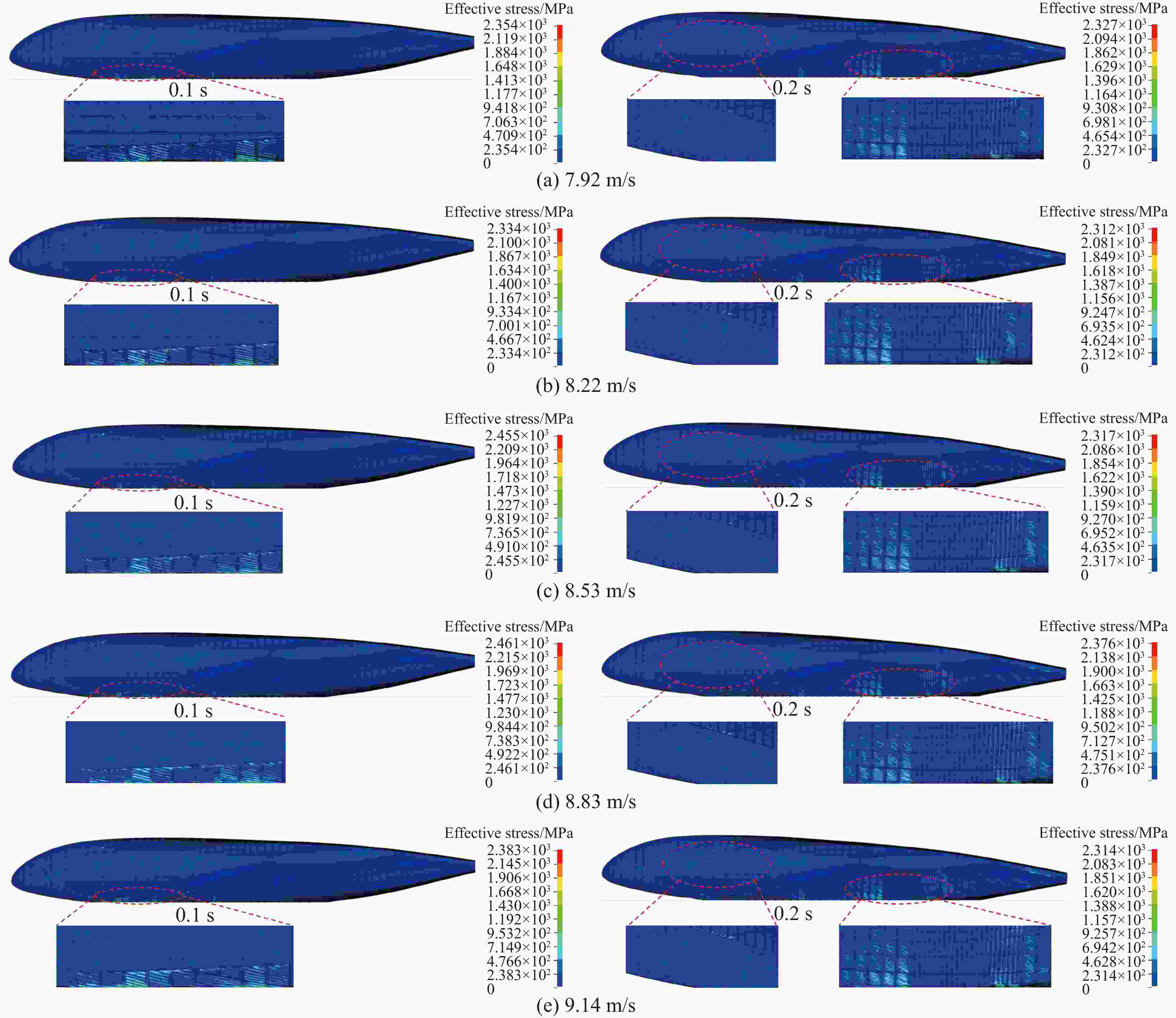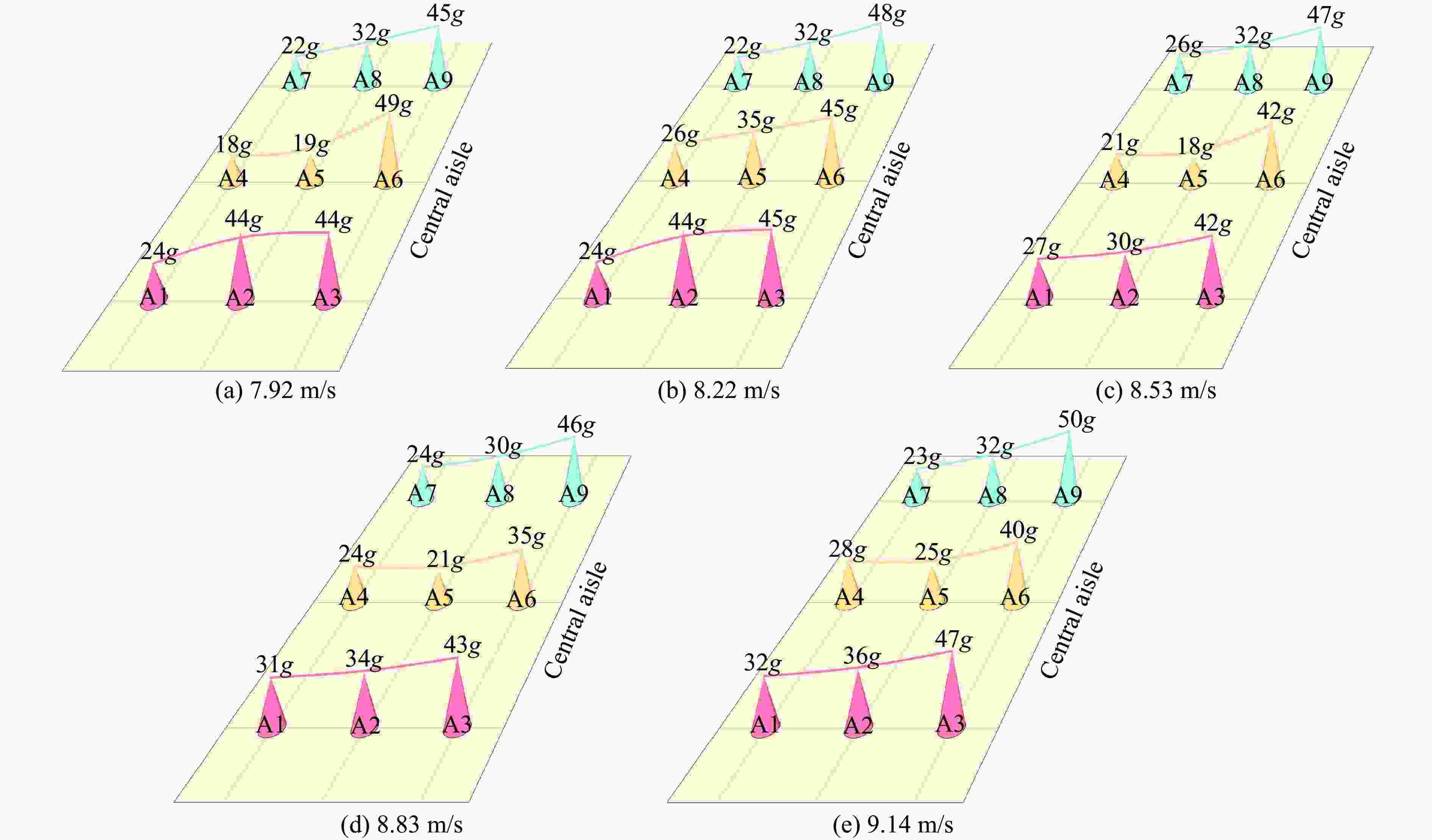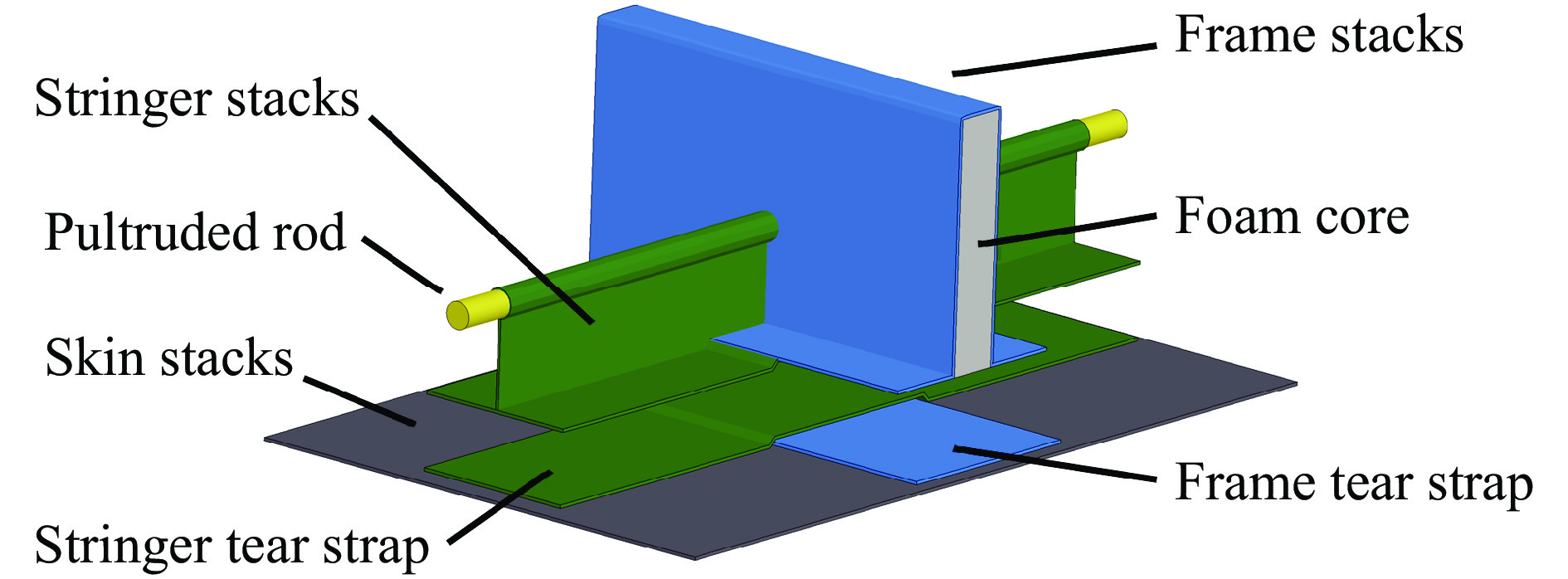Research on the crash response of blended-wing-body civil aircraft at different vertical velocity
-
摘要: 为了研究翼身融合(blended wing body, BWB)新构型民机的结构坠撞响应,以美国国家航空航天局提出的拉挤杆缝合一体化(pultruded rod stitched efficient unitized structure, PRSEUS)结构为基础,用临界机动载荷(2.5g过载和−1.0g过载)和客舱增压载荷(2倍客舱增压载荷)共3种典型载荷工况作为评估BWB结构强度、刚度的输入条件,建立了一款450座级的BWB民机结构模型。在垂向7.92~9.14 m/s的坠撞工况下,进行了数值模拟,重点分析了客舱空间保持情况、客舱地板的加速度响应以及主要承力结构的冲击特性。结果表明:BWB机身在不同冲击速度下客舱区域均基本保持完整,主要破坏发生在客舱地板以下区域,可生存空间得到保持;翼身融合构型民机在坠撞时产生的加速度响应分布呈现由中央过道向机体侧降低的趋势,且中央过道处的加速度峰值较高;结构吸能方面,隔框是最主要的吸能结构,其次是机身肋板,而货舱立柱未很好的压溃吸能。Abstract: Significant structural and layout disparities exist between the blended wing body (BWB) civil aircraft and conventional cylindrical fuselage metal aircraft. These differences render the impact resistance characteristics of the non-circular fuselage structure and the injury mechanisms for occupants unclear. To address this, a 460-seat BWB aircraft model was developed based on the pultruded rod stitched efficient unitized structure (PRSEUS) proposed by the National Aeronautics and Space Administration (NASA). The aircraft features a wingspan of 80 meters, a range of approximately 16,000 km, a cruising Mach number of 0.85, and a cruising altitude of 11 000 m. Three typical loading conditions were employed to evaluate the strength and stiffness of the BWB structure: critical maneuvering loads (2.5g positive overload and −1.0g negative overload) and cabin pressurization loads (double the cabin pressurization load). Through iterative structural design optimization, the model was confirmed to meet these typical loading requirements while demonstrating sufficient safety margins. The model incorporated all major structural components of the BWB configuration, including skin, frames, stringers, cargo floor, cabin floor, support columns, and fuselage ribs. In the finite element modeling process, elements with minimal influence on the crash response were reasonably simplified to reduce computational complexity. For instance, the outer wings and engines were simplified as concentrated mass points, and the cabin seats and passengers were modeled as concentrated masses fixed to the seat rails. The primary structural components, such as the skin, stringers, floor, and floor beams, were constructed from AS4 carbon fiber composite laminates and modeled using shell elements. The pultruded rods were made of AS4 carbon fiber composite and modeled using beam elements. The foam core of the frames and fuselage ribs were made of Rohacell-110-WF foam material and modeled using solid elements. The remaining structures were made of
7075 aluminum alloy and modeled using shell elements. The final model had a total mass of 162.87 tons and consisted of 2 679 991 elements. Five vertical impact velocities ranging from 7.92 to 9.14 m/s were selected to analyze the cabin space integrity, acceleration response of the cabin floor, and the impact characteristics of the primary load-bearing structures. The results indicate that the cabin area of the lift-body fuselage remains largely intact under the different impact velocities. The primary damage occurs below the cabin floor, with compressive damage concentrated in the lower structures of the middle and aft fuselage. The survivable space is preserved. Compared to a round-section fuselage, the deformation of the BWB frames is relatively small, and upward bulging is not significant, making it challenging to form effective plastic hinges. During the crash, the acceleration load distribution of the blended wing body-integrated aircraft exhibits a decreasing trend from the central aisle to the sides of the fuselage, with peak acceleration loads being higher at the central aisle. Under all five crash conditions, passenger injury levels at various cabin positions fall within the serious but acceptable and safe regions. Regarding structural energy absorption, the frames are identified as the primary energy-absorbing structures, followed by the fuselage ribs. However, the cargo pillars do not effectively crush and absorb energy. For future crashworthiness design of BWB civil aircraft, the cargo structure should be a key consideration.-
Key words:
- blended wing body /
- crash response /
- PRSEUS structure /
- occupant injury /
- crashworthiness
-
表 1 典型载荷工况
Table 1. Typical load cases
载荷工况 机动载荷 增压载荷 安全系数 1 2.5g 1.00p 1.5 2 −1.0g 1.00p 1.5 3 — 1.33p 1.5 表 2 优化参数
Table 2. Optimization parameters
部件名称 优化约束 二维应变 蒙皮 拉伸应变为6×10−3,压缩应变为4×10−3,
剪切应变为5×10−3平板稳定性 蒙皮 双轴压、剪切、双轴压与剪切耦合,rRF>0.67 一维应变 长桁 拉伸应变为6×10−3,压缩应变为4×10−3 框 拉伸应变为6×10−3,压缩应变为4×10−3 杆柱稳定性 长桁、框 局部稳定性、压损,rRF>1 加筋壁板稳定性 — rRF>0.67 表 3 简化结构的质量及重心位置
Table 3. The mass and center of gravity position of the simplifies structure
结构 质量/t 重心坐标 x/m y/m z/m 外翼 19.88 32.151508 3.441556 ± 23.799500 动力装置及垂尾 12.00 40.989216 4.548560 ± 7.643624 头顶行李箱及行李 12.08 表 4 复合材料的材料属性
Table 4. Properties of composite material
材料 弹性模量/GPa 剪切模量/GPa 泊松比 密度/(kg·m−3) 强度/MPa E11 E22 Xt Xc Yt Yc S AS4单向带材料 145 9 4.21 0.02 1 600 2200 1470 48.9 199 154 表 5 泡沫材料属性
Table 5. Material properties of foam
材料 拉伸模量/
MPa泊松比 密度/
(kg·m−3)拉伸截止应力/
MPaRohacell泡沫 180 0.375 1100 3.7 表 6 7075铝合金材料属性
Table 6. Material properties of 7075 aluminum
材料 拉伸模量/
GPa泊松比 密度/
(kg·m−3)失效应变 屈服应力/
MPa7075铝 70.326 0.33 2820 0.15 623 表 7 有限元模型的参数
Table 7. Properties of finite element model
外翼质量/t 结构质量/t 头顶行李架和行李质量/t 发动机和垂尾质量/t 总座椅和乘客质量/t 节点数 单元数 19.88 80.9 12.08 12 38.01 3 579 453 2 679 991 -
[1] OKONKWO P, SMITH H. Review of evolving trends in blended wing body aircraft design [J]. Progress in Aerospace Sciences, 2016, 82: 1–23. DOI: 10.1016/j.paerosci.2015.12.002. [2] 夏明, 巩文秀, 郑建强, 等. 欧美翼身融合大型民机方案综述 [J]. 民用飞机设计与研究, 2021(3): 123–134. DOI: 10.19416/j.cnki.1674-9804.2021.03.021.XIA M, GONG W X, ZHENG J Q, et al. A review of blended-wing-body for large civil aircraft of Europe and America [J]. Civil Aircraft Design & Research, 2021(3): 123–134. DOI: 10.19416/j.cnki.1674-9804.2021.03.021. [3] 张永杰, 吴莹莹, 赵书旺, 等. 翼身融合布局民机非圆截面机身结构设计研究综述 [J]. 航空学报, 2019, 40(9): 623054. DOI: 10.7527/S1000-6893.2019.23054.ZHANG Y J, WU Y Y, ZHAO S W, et al. Review of non-circular cross-section fuselage structure design research on blended-wing-body civil aircraft [J]. Acta Aeronautica et Astronautica Sinica, 2019, 40(9): 623054. DOI: 10.7527/S1000-6893.2019.23054. [4] MUKHOPADHYAY V, SOBIESZCZANSKI-SOBIESKI J, KOSAKA I, et al. Analysis, design, and optimization of noncylindrical fuselage for blended-wing-body vehicle [J]. Journal of Aircraft, 2004, 41(4): 925–930. DOI: 10.2514/1.417. [5] LIEBACK R. Blended wing body design challenges [C]//Proceedings of the AIAA International Air and Space Symposium and Exposition: the Next 100 Years. Dayton: AIAA, 2003: 2659. DOI: 10.2514/6.2003-2659. [6] VELICKI A, JEGLEY D. PRSEUS structural concept development [C]//Proceedings of the 52nd Aerospace Sciences Meeting. National Harbor: AIAA, 2014: 0259. DOI: 10.2514/6.2014-0259. [7] 张永杰, 周静飘, 石磊, 等. 基于PRSEUS结构的翼身融合民机中央机体球亏面框优化设计方法 [J]. 航空学报, 2024, 45(12): 229331. DOI: 10.7527/S1000-6893.2023.29331.ZHANG Y J, ZHOU J P, SHI L, et al. Optimization design method of central fuselage spherical deficient surface frames in blended-wing-body civil aircraft based on PRSEUS structure [J]. Acta Aeronautica et Astronautica Sinica, 2024, 45(12): 229331. DOI: 10.7527/S1000-6893.2023.29331. [8] HORNE M R, MADARAS E I. Evaluation of acoustic emission SHM of PRSEUS composite pressure cube tests: NASA/TM-2013-217993 [R]. Hampton: Langley Research Center, 2013. [9] 解江, 牟浩蕾, 冯振宇. 运输类飞机适坠性合格审定导论 [M]. 北京: 中国民航出版社, 2022: 11-17. [10] GUIDA M, MARULO F, ABRATE S. Advances in crash dynamics for aircraft safety [J]. Progress in Aerospace Sciences, 2018, 98: 106–123. DOI: 10.1016/j.paerosci.2018.03.008. [11] 任毅如, 向锦武, 罗漳平, 等. 飞行器机身结构耐撞性分析与设计 [J]. 工程力学, 2013, 30(10): 296–304. DOI: 10.6052/j.issn.1000-4750.2012.07.0478.REN Y R, XIANG J W, LUO Z P, et al. Crashworthiness analysis and design of aircraft fuselage structure [J]. Engineering Mechanics, 2013, 30(10): 296–304. DOI: 10.6052/j.issn.1000-4750.2012.07.0478. [12] 郑建强, 向锦武, 罗漳平, 等. 民机机身下部结构耐撞性优化设计 [J]. 航空学报, 2012, 33(4): 640–649. DOI: CNKI:11-1929/V.20111011.1411.006.ZHENG J Q, XIANG J W, LUO Z P, et al. Crashworthiness optimization of civil aircraft subfloor structure [J]. Acta Aeronautica et Astronautica Sinica, 2012, 33(4): 640–649. DOI: CNKI:11-1929/V.20111011.1411.006. [13] 张欣玥, 惠旭龙, 刘小川, 等. 典型金属民机机身结构坠撞特性试验 [J]. 航空学报, 2022, 43(6): 526234. DOI: 10.7527/S1000-6893.2022.26234.ZHANG X Y, HUI X L, LIU X C, et al. Experimental study on crash characteristics of typical metal civil aircraft fuselage structure [J]. Acta Aeronautica et Astronautica Sinica, 2022, 43(6): 526234. DOI: 10.7527/S1000-6893.2022.26234. [14] CAPUTO F, LAMANNA G, PERFETTO D, et al. Experimental and numerical crashworthiness study of a full-scale composite fuselage section [J]. AIAA Journal, 2021, 59(2): 700–718. DOI: 10.2514/1.J059216. [15] 解江, 牟浩蕾, 冯振宇, 等. 大飞机典型货舱下部结构冲击试验及数值模拟 [J]. 航空学报, 2022, 43(6): 525890. DOI: 10.7527/S1000-6893.2021.25890.XIE J, MOU H L FENG Z Y, et al. Impact characteristics of typical sub-cargo structure of large aircraft: tests and numerical simulation [J]. Acta Aeronautica et Astronautica Sinica, 2022, 43(6): 525890. DOI: 10.7527/S1000-6893.2021.25890. [16] 杨强, 惠旭龙, 白春玉, 等. 高锁螺栓连接件动态拉伸响应与失效机理 [J]. 爆炸与冲击, 2020, 40(10): 103102. DOI: 10.11883/bzycj-2019-0475.YANG Q, HUI X L, BAI C Y, et al. Dynamic tensile response and failure mechanism of hi-lock bolt joint [J]. Explosion and Shock Waves, 2020, 40(10): 103102. DOI: 10.11883/bzycj-2019-0475. [17] 刘小川, 郭军, 孙侠生, 等. 民机机身段和舱内设施坠撞试验及结构适坠性评估 [J]. 航空学报, 2013, 34(9): 2130–2140. DOI: 10.7527/S1000-6893.2013.0182.LIU X C, GUO J, SUN X S, et al. Drop test and structure crashworthiness evaluation of civil airplane fuselage section with cabin interiors [J]. Acta Aeronautica et Astronautica Sinica, 2013, 34(9): 2130–2140. DOI: 10.7527/S1000-6893.2013.0182. [18] 牟浩蕾, 解江, 冯振宇, 等. 大型运输类飞机典型机身框段坠撞特性分析 [J]. 航空学报, 2023, 44(9): 227512. DOI: 10.7527/S1000-6893.2022.27512.MOU H L, XIE J, FENG Z Y, et al. Crashworthiness characteristics analysis of typical fuselage section of large transport aircraft [J]. Acta Aeronautica et Astronautica Sinica, 2023, 44(9): 227512. DOI: 10.7527/S1000-6893.2022.27512. [19] FASANELLA E L, WIDMAYER E, ROBINSON M P. Structural analysis of the controlled impact demonstration of a jet transport airplane [J]. Journal of Aircraft, 1987, 24(4): 274–280. DOI: 10.2514/3.45437. [20] JACKSON K E, FASANELLA E L. Development of an LS-DYNA model of an ATR42-300 aircraft for crash simulation [C]//Proceedings of the ICRASH 2004-International Crashworthiness Conference. San Francisco: Langley Research Center, 2004. [21] JACKSON K E, PUTNAM J B. Simulation of a full-scale crash test of a Fokker F28 fellowship aircraft: NASA/TM-2020-220435 [R]. Hampton: Langley Research Center, 2020. [22] 刘小川, 惠旭龙, 张欣玥, 等. 典型民用飞机全机坠撞实验研究 [J]. 航空学报, 2024, 45(5): 529664. DOI: 10.7527/S1000-6893.2023.29664.LIU X C, HUI X L, ZHANG X Y, et al. Full-scale crash experimental study of typical civil aircraft [J]. Acta Aeronautica et Astronautica Sinica, 2024, 45(5): 529664. DOI: 10.7527/S1000-6893.2023.29664. [23] STURM R, HEPPERLE M. Crashworthiness and ditching behaviour of blended-wing-body (BWB) aircraft design [J]. International Journal of Crashworthiness, 2015, 20(6): 592–601. DOI: 10.1080/13588265.2015.1068997. [24] CUI Z, LAI G J, WANG Q F, et al. Wind tunnel investigation of different engine layouts of a blended-wing-body transport [J]. Chinese Journal of Aeronautics, 2023, 36(9): 123–132. DOI: 10.1016/j.cja.2023.04.027. [25] VELICKI A, YOVANOF N, BARAJA J, et al. Damage arresting composites for shaped vehicles - phase II final report: NASA/CR-2011-216880 [R]. Houston: NASA, 2011. [26] 中国民用航空局. CCAR-25-R4 运输类飞机适航标准 [S]. 北京: 中华人民共和国交通运输部, 2011. [27] 刘小川, 张欣玥, 惠旭龙, 等. 结构修理对民机机身耐撞性的影响 [J]. 航空学报, 2023, 44(10): 227517. DOI: 10.7527/S1000-6893.2022.27517.LIU X C, ZHANG X Y, HUI X L, et al. Influence of structural repairs on crashworthiness of civil aircraft fuselage [J]. Acta Aeronautica et Astronautica Sinica, 2023, 44(10): 227517. DOI: 10.7527/S1000-6893.2022.27517. [28] Transport Aircraft Crashworthiness and Ditching Working Group. Transport aircraft crashworthiness and ditching working group report to FAA [R]. Washington: Federal Aviation Administration, 2018. [29] 程坤. 典型运输类飞机客舱地板下部结构坠撞特性研究 [D]. 天津: 中国民航大学, 2020: 25–46. [30] EIBAND A M. Human tolerance to rapidly applied accelerations: a summary of the literature: NASA-MEMO-5-19-59E [R]. Cleveland: NASA Lewis Research Center, 1959. -







 下载:
下载:
